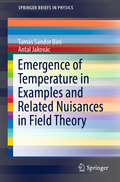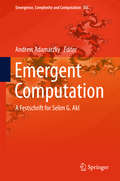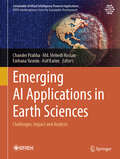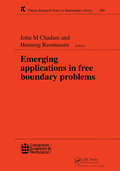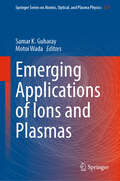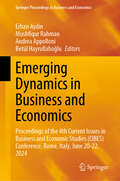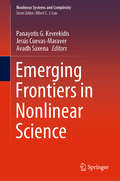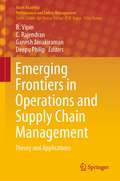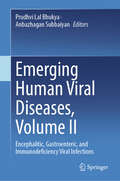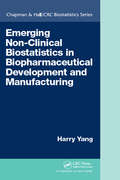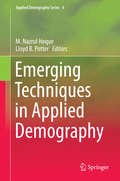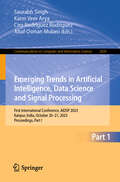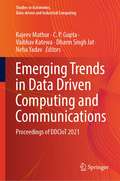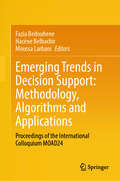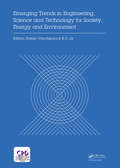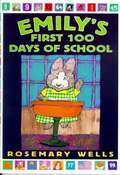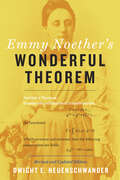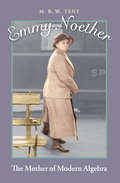- Table View
- List View
Emeka's Gift: An African Counting Book
by Ifeoma OnyefuluAs a young African boy travels to visit his grandmother, he passes through the village market, where he sees lots of things Granny would like -- four brooms, five hats, six necklaces, seven musical instruments, and so on. Stunning photographs taken in Emeka's southern Nigerian village illustrate this heartwarming story. The pages in this book are not numbered. Other books by this author are available in this library.
Emergence of Temperature in Examples and Related Nuisances in Field Theory (SpringerBriefs in Physics)
by Antal Jakovác Tamás Sándor BiróField theory, relying on the concept of continuous space and time while confronted with the quantum physical nature of observable quantities, still has some fundamental challenges to face. One such challenge is to understand the emergence of complexity in the behavior of interacting elementary fields, including among other things nontrivial phase structures of elementary matter at high energy density or an atypical emergence of statistical properties, e.g., when an apparent temperature is proportional to a constant acceleration in a homogeneous gravitational field. Most modern textbooks on thermal field theory are mainly concerned with how the field theory formalism should be used if a finite temperature is given. In contrast, this short primer explores how the phenomenon of temperature emerges physically for elementary fields - inquiring about the underlying kinetic field theory and the way energy fluctuations and other noise should be handled - and it investigates whether and how this harmonizes with traditional field theory concepts like spectral evolution, the Keldysh formalism, and phase transitions.
Emergent Computation
by Andrew AdamatzkyThis book is dedicated to Professor Selim G. Akl to honour his groundbreaking research achievements in computer science over four decades. The book is an intellectually stimulating excursion into emergent computing paradigms, architectures and implementations. World top experts in computer science, engineering and mathematics overview exciting and intriguing topics of musical rhythms generation algorithms, analyse the computational power of random walks, dispelling a myth of computational universality, computability and complexity at the microscopic level of synchronous computation, descriptional complexity of error detection, quantum cryptography, context-free parallel communicating grammar systems, fault tolerance of hypercubes, finite automata theory of bulk-synchronous parallel computing, dealing with silent data corruptions in high-performance computing, parallel sorting on graphics processing units, mining for functional dependencies in relational databases, cellular automata optimisation of wireless sensors networks, connectivity preserving network transformers, constrained resource networks, vague computing, parallel evolutionary optimisation, emergent behaviour in multi-agent systems, vehicular clouds, epigenetic drug discovery, dimensionality reduction for intrusion detection systems, physical maze solvers, computer chess, parallel algorithms to string alignment, detection of community structure. The book is a unique combination of vibrant essays which inspires scientists and engineers to exploit natural phenomena in designs of computing architectures of the future.
Emerging AI Applications in Earth Sciences: Challenges, Impact and Analysis (Sustainable Artificial Intelligence-Powered Applications)
by Md. Mehedi Hassan Farhana Yasmin Chander Prabha Asif KarimThis proposed book provides deeper insights into artificial intelligence techniques and procedures available for earth sciences. This book unveils several applications of metaheuristic approaches (i.e., swarm intelligence and IoT technologies) in collaboration with AI for earth sciences. It presents the science behind smart technologies that reveal the power of artificial intelligence and IoT. These methodologies help to extract meaningful insights from earth sciences big data analytics. These advanced technologies used in earth science practices can remove geographical barriers, locally adaptive, operationally feasible, and economically affordable. The areas can be explored with the aim of digitizing the whole world. Technological advancement also impacts the financial aspect involved in managing the earth sciences. Intelligent AI applications have made significant strides in the field of earth sciences, offering novel solutions to complex challenges, driving impactful research, and revolutionizing data analysis and interpretation. This intersection of artificial intelligence and earth sciences has paved the way for an enhanced understanding of our planet and its various phenomena.
Emerging Applications in Free Boundary Problems (Chapman And Hall/crc Research Notes In Mathematics Ser.)
by J M ChadamThis Research Note presents a collection of papers on emerging applications in free boundaryproblems. The subjects covered include microgravity, chemical and biological reactions, and electromagnetism and electronics.
Emerging Applications of Control and Systems Theory: A Festschrift In Honor Of Mathukumalli Vidyasagar (Lecture Notes In Control And Information Sciences - Proceedings Ser.)
by Roberto Tempo Stephen Yurkovich Pradeep MisraThis book celebrates Professor Mathukumalli Vidyasagar’s outstanding achievements in systems, control, robotics, statistical learning, computational biology, and allied areas. The contributions in the book summarize the content of invited lectures given at the workshop “Emerging Applications of Control and Systems Theory” (EACST17) held at the University of Texas at Dallas in late September 2017 in honor of Professor Vidyasagar’s seventieth birthday. These contributions are the work of twenty-eight distinguished speakers from eight countries and are related to Professor Vidyasagar’s areas of research. This Festschrift volume will remain as a permanent scientific record of this event.
Emerging Applications of Ions and Plasmas (Springer Series on Atomic, Optical, and Plasma Physics #127)
by Samar K. Guharay Motoi WadaThis book discusses recent advances in the science and technology of charged particles and emerging frontiers in applications of ions and plasmas. In particular, this includes: ion/plasma interactions with soft matters, especially, interrogating local bio cells, bio systems, liquids and gels; interactions with ambient environments; processes associated with fine-scale characterization of materials, materials modification, new material discovery, and above all, plasma chemistry. The book takes a broad view of the underlying problems with a distinct aim to engage young researchers and even advanced undergraduate and beginning graduate students. The first few chapters discuss relevant broad science issues covering ions and plasmas as well as methodologies for their manipulations; in addition, mathematical and computational tools for analysis are highlighted through simple examples. This background knowledge, in turn, develops a solid foundation for the chapters on numerous emerging application areas. A balance between science and engineering, along with relevant computational modeling, simulation, and exploitation of data, is maintained throughout. Prospective outlooks for the future are discussed. Overall, this book offers a lens for the reader to get acquainted with active and fruitful emerging application domains for future explorations.
Emerging Dynamics in Business and Economics: Proceedings of the 4th Current Issues in Business and Economic Studies (CIBES) Conference, Rome, Italy, June 20-22, 2024 (Springer Proceedings in Business and Economics)
by Mushfiqur Rahman Andrea Appolloni Erhan Aydin Betül HayrullahoğluThis volume features a collection of selected papers presented at the 4th Current Issues in Business and Economic Studies (CIBES) Conference, held in Frascati (Rome) from June 20-22, 2024. The CIBES Conference offers global perspectives on business and economic research, incorporating analysis at the micro-individual, meso-organizational, and macro-national levels. This book provides a comprehensive overview of contemporary research topics such as sustainable business practices, the impact of digital transformation on global markets, the dynamics of global trade, the future of work, the economic effects of global health challenges, innovation in entrepreneurship, and issues of equality, diversity, and inclusion. Additionally, it proposes frameworks and recommendations to assist organizations and researchers in addressing and managing the complexities of the global business and economic environment effectively. Through this lens, the book seeks to contribute valuable insights and methodologies to the fields of business and economics, serving as a vital resource for academics, practitioners, and policymakers engaged in understanding and navigating the intricate landscape of global business and economic challenges.
Emerging Frontiers in Nonlinear Science (Nonlinear Systems and Complexity #32)
by Avadh Saxena Jesús Cuevas-Maraver Panayotis G. KevrekidisThis book explores the impact of nonlinearity on a broad range of areas, including time-honored fields such as biology, geometry, and topology, but also modern ones such as quantum mechanics, networks, metamaterials and artificial intelligence. The concept of nonlinearity is a universal feature in mathematics, physics, chemistry and biology, and is used to characterize systems whose behavior does not amount to a superposition of simple building blocks, but rather features complex and often chaotic patterns and phenomena. Each chapter of the book features a synopsis that not only recaps the recent progress in each field but also charts the challenges that lie ahead. This interdisciplinary book presents contributions from a diverse group of experts from various fields to provide an overview of each field’s past, present and future. It will appeal to both beginners and seasoned researchers in nonlinear science, numerous areas of physics (optics, quantum physics, biophysics), and applied mathematics (ODEs, PDEs, dynamical systems, machine learning) as well as engineering.
Emerging Frontiers in Operations and Supply Chain Management: Theory and Applications (Asset Analytics)
by C. Rajendran B. Vipin Ganesh Janakiraman Deepu PhilipThis edited book addresses the challenges in managing the operations and supply chain of organizations in the era of internet of things and Industry 4.0. It presents cutting edge research on real world operations related problems, in-depth analyses, and relevant managerial implications. Wide variety of solution approaches such as quantitative, quantitative, and simulations are presented in the context of managing the operations and supply chains. Consisting of selected papers from the XXIII Annual International Conference of Society of Operations Management, this volume is part of a two volume series with the other book consisting of chapters on quantitative decision making. This edited book covers various quantitative models on operations and supply chain management such as inventory optimization, machine learning-operations research integrated model for healthcare systems, game-theoretic analysis of review strategies in truthful information sharing, design of contracts in supply chains, supply chain optimization, inventory routing, and shop floor scheduling. In addition to the quantitative models, several innovative heuristics are proposed for different problems. This book explores qualitative models on improving the performance of small and medium enterprises and petroleum industries and a simulation model for staff allocation in the information technology industry. Finally, this book provides review articles on vaccine supply chains and behavioral operations management.The book throws light on the emerging trends in the use of analytics, optimization, and simulation tools and empirical analysis to improve the performance of operations and supply chains of organizations. It will serve as an essential resource for practitioners, students, faculty members and scholars in operations management and related areas to gain knowledge and pursue high quality research on developments in areas such as managing the resource management and the solution methodology---innovative tools employed in addressing the real world problems and the different optimization techniques.
Emerging Human Viral Diseases, Volume II: Encephalitic, Gastroenteric, and Immunodeficiency Viral Infections
by Prudhvi Lal Bhukya Anbazhagan SubbaiyanThe second volume of the book Emerging Human Viral Diseases discusses pathogenesis, diagnostics, and therapeutic strategies against viral encephalitis, gastroenteritis, and human immunodeficiency viral infections. The chapters discuss symptoms, diagnostics, and preventive strategies against viral infections. The book also reviews the epidemiology and evolution of viruses causing these infections. It also examines symptoms and strategies for developing novel diagnostics and the vaccine against these viruses. Toward the end, it discusses various biosafety principles for handling emerging viruses and reviews various bioinformatics tools and databases in virology research. This timely book offers valuable resource for the scientists working in the field of emerging viral infections and those involved in preventing, controlling, and managing viral diseases. Inclusively this book will be valuable guide covering most recent scientific progress in emerging human viral diseases and management and will serve as the best resource for undergraduates, graduates, medical professionals, researchers, public health physicians, and national and international health authorities.
Emerging Markets: Performance, Analysis and Innovation (Chapman & Hall/CRC Finance Series)
by Greg N. GregoriouAlthough emerging market economies consist of 50% of the global population, they are relatively unknown. Filling this knowledge gap, Emerging Markets: Performance, Analysis and Innovation compiles the latest research by noteworthy academics and money managers from around the world. With a focus on both traditional emerging markets and new areas, su
Emerging Non-Clinical Biostatistics in Biopharmaceutical Development and Manufacturing (Chapman & Hall/CRC Biostatistics Series)
by Harry YangThe premise of Quality by Design (QbD) is that the quality of the pharmaceutical product should be based upon a thorough understanding of both the product and the manufacturing process. This state-of-the-art book provides a single source of information on emerging statistical approaches to QbD and risk-based pharmaceutical development. A comprehensive resource, it combines in-depth explanations of advanced statistical methods with real-life case studies that illustrate practical applications of these methods in QbD implementation.
Emerging Problems in the Homogenization of Partial Differential Equations (SEMA SIMAI Springer Series #10)
by Patrizia Donato Manuel Luna-LaynezThis book contains some of the results presented at the mini-symposium titled Emerging Problems in the Homogenization of Partial Differential Equations, held during the ICIAM2019 conference in Valencia in July 2019. The papers cover a large range of topics, problems with weak regularity data involving renormalized solutions, eigenvalue problems for complicated shapes of the domain, homogenization of partial differential problems with strongly alternating boundary conditions of Robin type with large parameters, multiscale analysis of the potential action along a neuron with a myelinated axon, and multi-scale model of magnetorheological suspensions. The volume is addressed to scientists who deal with complex systems that presents several elements (characteristics, constituents...) of very different scales, very heterogeneous, and search for homogenized models providing an effective (macroscopic) description of their behaviors.
Emerging Techniques in Applied Demography
by M. Nazrul Hoque Lloyd B. PotterBy bringing together top-notch demographers, sociologists, economists, statisticians and public health specialists from Asia, Africa, Europe, and North America to examine a wide variety of public and private issues in applied demography, this book spans a wide range of topics. It evaluates population estimates and projections against actual census counts and suggests further improvement of estimates and projection techniques and evaluation procedures; new techniques are proposed for estimating families and households and particular attention is paid to the much-discussed topic of access to health care. Coverage extends to factors influencing health status and elder abuse, child bearing and labor market analysis and the effects of education on labor market outcomes of native white American and immigrant European populations. Methodologically rigorous and pragmatically useful, Emerging Techniques in Applied Demography also examines a wide variety of public and private issues under the field of applied demography. It provides a broad overview of research topics and also reflects substantial development in the field of applied demography. It also bridges the gap between theory and research by providing several examples of work of distinguished applied demographic.
Emerging Trends in Artificial Intelligence, Data Science and Signal Processing: First International Conference, AIDSP 2023, Kanpur, India, October 20–21, 2023, Proceedings, Part I (Communications in Computer and Information Science #2439)
by Karm Veer Arya Saurabh Singh Ciro Rodriguez Rodriguez Altaf Osman MulaniThe two-volume set, CCIS 2439 and CCIS 2440, constitutes the proceedings of the First International Conference on Emerging Trends in Artificial Intelligence, Data Science and Signal Processing, AIDSP 2023, held in Kanpur, India, in October 2023. The 25 full papers and 11 Short papers in this book were carefully reviewed and selected from 260 submissions. These papers focus on the topics such as Artificial Intelligence, Machine Learning and Signal Processing.
Emerging Trends in Artificial Intelligence, Data Science and Signal Processing: First International Conference, AIDSP 2023, Kanpur, India, October 20–21, 2023, Proceedings, Part II (Communications in Computer and Information Science #2440)
by Karm Veer Arya Saurabh Singh Ciro Rodriguez Rodriguez Altaf Osman MulaniThe two-volume set, CCIS 2439 and CCIS 2440, constitutes the proceedings of the First International Conference on Emerging Trends in Artificial Intelligence, Data Science and Signal Processing, AIDSP 2023, held in Kanpur, India, in October 2023. The 25 full papers and 11 Short papers in this book were carefully reviewed and selected from 260 submissions. These papers focus on the topics such as Artificial Intelligence, Machine Learning and Signal Processing.
Emerging Trends in Data Driven Computing and Communications: Proceedings of DDCIoT 2021 (Studies in Autonomic, Data-driven and Industrial Computing)
by Neha Yadav Dharm Singh Jat Rajeev Mathur C. P. Gupta Vaibhav KatewaThis book includes best selected, high-quality research papers presented at International Conference on Data Driven Computing and IoT (DDCIoT 2021) organized jointly by Geetanjali Institute of Technical Studies (GITS), Udaipur, and Rajasthan Technical University, Kota, India, during March 20–21, 2021. This book presents influential ideas and systems in the field of data driven computing, information technology, and intelligent systems.
Emerging Trends in Decision Support: Proceedings of the International Colloquium MOAD24
by Moussa Larbani Fazia Bedouhene Hacène BelbachirThis book includes the peer-reviewed proceedings of the Sixth Edition of the International Colloquium MOAD24 which was held at Mouloud Mammeri University of Tizi-Ouzou, Algeria, Oct 20-22, 2024. It consists of nine parts which cover the main aspects of decision support such as analysis, predictive, mathematical, algorithmic, operational, and economic. The methods developed in this book are based on optimization, graph theory, combinatorics, game theory, control theory, probability and statistics, simulation, stochastic processes, data mining, machine learning, artificial intelligence, fuzzy set theory and mathematical modelling. Its outcomes can be implemented for analysis and prediction in different areas of human activities such as management, economics, knowledge extraction from big data, system control, cyber security, medicine, engineering, and politics. This book can be a good support for decision makers, R&D departments, and researchers in related fields.
Emerging Trends in Engineering, Science and Technology for Society, Energy and Environment: Proceedings of the International Conference in Emerging Trends in Engineering, Science and Technology (ICETEST 2018), January 18-20, 2018, Thrissur, Kerala, India
by Rajesh Vanchipura K. S. JijiThe International Conference on Emerging Trends in Engineering, Science and Technology (ICETEST) was held at the Government Engineering College, Thrissur, Kerala, India, from 18th to 20th January 2018, with the theme, “Society, Energy and Environment”, covering related topics in the areas of Civil Engineering, Mechanical Engineering, Electrical Engineering, Chemical Engineering, Electronics & Communication Engineering, Computer Science and Architecture. Conflict between energy and environment has been of global significance in recent years. Academic research needs to support the industry and society through socially and environmentally sustainable outcomes. ICETEST 2018 was organized with this specific objective. The conference provided a platform for researchers from different domains, to discuss and disseminate their findings. Outstanding speakers, faculties, and scholars from different parts of the world presented their research outcomes in modern technologies using sustainable technologies.
Emerging Wireless Technologies and Sciences: Second International Conference, ICEWTS 2024, Uttarakhand, India, October 6–7, 2024, Proceedings (Communications in Computer and Information Science #2399)
by Ashish Bagwari Durg Singh Chauhan Eduard Babulak Jorge Luis Victoria BarbosaThis book constitutes the refereed proceedings of the Second International Conference on Emerging Wireless Technologies and Sciences, ICEWTS 2024, held in Uttarakhand, India, during October 6–7, 2024.The 8 full papers and 4 short papers included in this book were carefully reviewed and selected from 430 submissions. They focus on multidisciplinary framework of communication engineering, wireless sensor networks, electrical engineering, renewable energies, materials science, physics, mathematics, computer, environment, and many more.
Emily's First 100 Days of School
by Rosemary WellsFrom the book: On the first day of school I leave my mama's arms. I am too excited to cry. Emily is ready for her first day of school. There's so much to do: learning the alphabet, singing, reading books, dancing, and counting, starting with the very first day. "When we reach one hundred days, we will have a big party," says Miss Cribbage. One hundred days feels very far away, but day by day, Emily and her classmates see they're getting closer. And as the lessons they learn begin to add up, their world expands. Emily's First 100 Days of School is a celebration of the joy of learning. Supported by a vital community of family, friends, neighbors, and teachers, a child develops her own rhythm and timing for exploring the wonders of the world around her.
Emmy Noether's Wonderful Theorem
by Dwight E. NeuenschwanderOne of the most important—and beautiful—mathematical solutions ever devised, Noether’s theorem touches on every aspect of physics."In the judgment of the most competent living mathematicians, Fräulein Noether was the most significant creative mathematical genius thus far produced since the higher education of women began."—Albert EinsteinThe year was 1915, and the young mathematician Emmy Noether had just settled into Göttingen University when Albert Einstein visited to lecture on his nearly finished general theory of relativity. Two leading mathematicians of the day, David Hilbert and Felix Klein, dug into the new theory with gusto, but had difficulty reconciling it with what was known about the conservation of energy. Knowing of her expertise in invariance theory, they requested Noether’s help. To solve the problem, she developed a novel theorem, applicable across all of physics, which relates conservation laws to continuous symmetries—one of the most important pieces of mathematical reasoning ever developed.Noether’s "first" and "second" theorem was published in 1918. The first theorem relates symmetries under global spacetime transformations to the conservation of energy and momentum, and symmetry under global gauge transformations to charge conservation. In continuum mechanics and field theories, these conservation laws are expressed as equations of continuity. The second theorem, an extension of the first, allows transformations with local gauge invariance, and the equations of continuity acquire the covariant derivative characteristic of coupled matter-field systems. General relativity, it turns out, exhibits local gauge invariance. Noether’s theorem also laid the foundation for later generations to apply local gauge invariance to theories of elementary particle interactions. In Dwight E. Neuenschwander’s new edition of Emmy Noether’s Wonderful Theorem, readers will encounter an updated explanation of Noether’s "first" theorem. The discussion of local gauge invariance has been expanded into a detailed presentation of the motivation, proof, and applications of the "second" theorem, including Noether’s resolution of concerns about general relativity. Other refinements in the new edition include an enlarged biography of Emmy Noether’s life and work, parallels drawn between the present approach and Noether’s original 1918 paper, and a summary of the logic behind Noether’s theorem.
Emmy Noether: The Mother of Modern Algebra
by M. B. TentThis book, written primarily for the young adult reader, tells the life story of Emmy Noether, the most important female mathematician of our time. Because no one expected her to grow into an important scientist, the records of her early life are sketchy. After all, it was assumed that she would grow up to be a wife and mother. Instead, she was a g
Emotion Detection in Natural Language Processing (Synthesis Lectures on Human Language Technologies)
by Federica CavicchioThis book provides a practical guide on annotating emotions in natural language data and showcases how these annotations can improve Natural Language Processing (NLP) and Natural Language Understanding (NLU) models and applications. The author presents an introduction to emotion as well as the ethical considerations on emotion annotation. State-of-the-art approaches to emotion annotation in NLP and NLU including rule-based, machine learning, and deep learning applications are addressed. Theoretical foundations of emotion and the implication on emotion annotation are discussed along with the current challenges and limitations in emotion annotation. This book is appropriate for researchers and practitioners in the field of NLP and NLU and anyone interested in the intersection of natural language and emotion.

